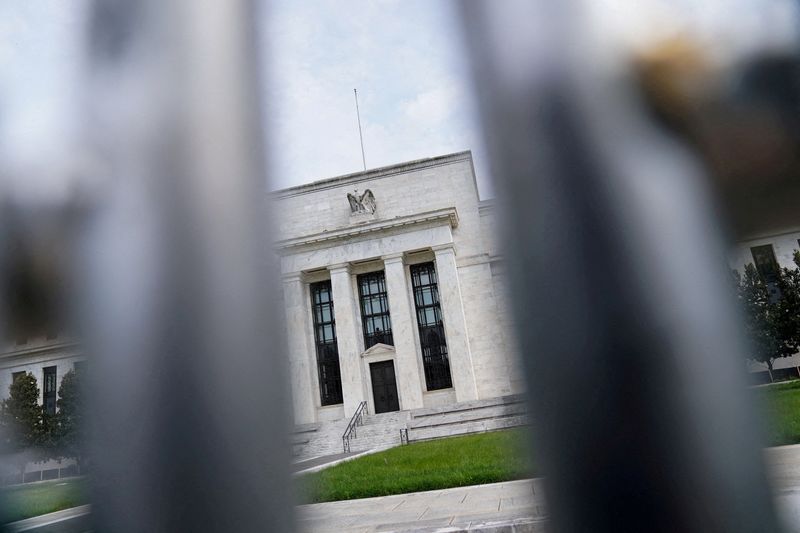By Mike Dolan
LONDON (Reuters) -Rising U.S. business bankruptcies may raise a red flag in what otherwise appears like an economy now impervious to rising interest rates.
News of accelerating service sector growth last month and another drop in jobless claims this week are just the latest in a string of data showing the U.S. economy was not only resilient in the face of 18 months of steep Federal Reserve rate hikes but actually picking up steam again.
Alongside surging retail sales in July, the updates have seen third-quarter U.S. national output estimates revised higher and pose problems for a Fed deciding whether to end its severe tightening campaign - and now wait for the negative effects to kick in with a lag.
Bond markets are unnerved by the heat of the rebound - irked by a fresh tick higher in headline inflation and annual crude oil prices turning positive again for the first time since January - just as heavy government debt sales hit the market.
But while the long-heralded recession seems ever further away, there are some signs the rate squeeze is starting to hurt many small- and medium-sized businesses - despite the remarkable buoyancy of mega-cap stock market bellwethers this year.
For all its idiosyncrasies, the high-profile corporate bust of trucking company Yellow Corp last month seems far from an isolated case.
According to bankruptcy filing tracker Epiq Bankruptcy, there were 634 commercial Chapter 11 filings in August - a jump of 54% from the same month last year - and a 13th straight month of year-on-year rises in both commercial and individual filings.
Commenting on the numbers, insolvency research organisation ABI blamed elevated interest rates, price inflation and a resumption of student loan payments as just some of the headwinds causing stress.
Official quarterly statistics on total U.S. business bankruptcies in the 12 months through midyear have remained well below pre-pandemic levels - but the annual rate of increase of that measure was by June at a rate not seen since 2010.
Narrowing down the subset to companies with a minimum of $2 million in assets and liabilities, S&P Global (NYSE:SPGI) Market Intelligence recorded 64 new bankruptcies in July - the largest monthly total since March and more single month filings than any month in 2021 or 2022.
And it claimed cumulative Chapter 11 filings in the first seven months of 2023 exceeded the total for all of last year - higher at that point of the year than any equivalent timespan over the past 13 years.
'MADDEST MACRO CHART'
Seizing on the Epiq bankruptcy data for August, Societe Generale (EPA:SOGN) strategist Albert Edwards said the numbers were an example of the uneven hit to U.S. companies from what on the surface looks like a puzzling impotence in Fed policy.
Edwards and fellow SocGen strategist Andrew Lapthorne have this summer spotlighted what they dub the 'maddest macro chart' - a seemingly contradictory 30% annual drop in overall corporate net interest payments even as Fed policy rates and long-term borrowing costs have spiralled higher over the past year.
That partly mirrors some of built-in household resilience to rising rates related to long-term fixed-rate borrowings and still-high cash savings that now earn significantly higher rates of interest now too.
But listed companies with high cash levels are skewed to the very top of the tree.
Lapthorne showed how the ratio of earnings to interest payments for the Russell 2000 small caps was just 2.5 times - compared with 13 times for the top 10% of the S&P1500.
And that 10% - accounting for more than 60% of index market cap - had seen no rise in net interest payments so far in the Fed campaign. It holds 70% of the overall cash, now earning handsome interest returns.
The SocGen strategists claim this has flattered total U.S. profits by up to 20% relative to a normal tightening cycle and likely helped delay the onset of any recession.
Little surprise then that the relatively modest 5% Russell 2000 gain so far this year is third of the broader market.
But creeping insolvencies among the smaller firms - many of whom have been dubbed 'zombies' for years due to their survival solely on low interest rates - may be a better reflection of what's starting to happen at the coalface of the economy.
"If you look just below the very large-cap stocks, the 'old normal' still applies with higher rates triggering a surge in corporate bankruptcies that will surely lay low the overall economy," wrote Edwards, a long-standing equity market bear.
The flipside of course is that total bankruptcies remain low despite the sharp upswing and small businesses - which employ the majority of U.S. workers and may dictate the strength of jobs market and consumer spending by extension - claim to be stabilising.
Up to July at least, a monthly survey of small firms conducted by the National Federation of Independent Business showed confidence levels at their highest in eight months - even if still struggling to recover from last year's battering.
That was despite the fact that average rate paid on short-term loans for small businesses shot up to 9.2% in June, up 1.4 percentage points from May's reading and marking the largest increase since December 2006.
And yet 62% of the firms NFIB polled said they were not interested in a loan and 25% said all credit needs were met.

An August survey update will be watched very closely.
The opinions expressed here are those of the author, a columnist for Reuters.